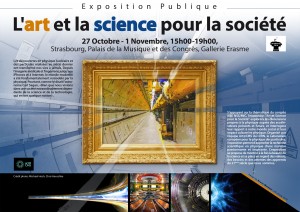Every scientist can tell you about the beauty of his or her research. But while a small bump in a curve may delight particle physicists, most people just see a bunch of coloured lines. And the perfection of a complex theoretical model is evident only for a select few. Probably everybody would agree that science has made our world a better place. But who would say that it helps to make our lives more beautiful?
So arts and science don’t seem to be too closely connected. But luckily there are quite a few people who try to reveal the art and beauty in science and physics in particular. CERN has been hosting so-called artists in residence programmes for many years now and a lot of spectacular projects have emerged from the cooperation of artists and scientists. The International Linear Collider also has inspired artistic work from the beginning. Some examples were the ILC-theme exhibition in Roppongi, downtown Tokyo with an ILC mock-up made from rammed earth or Science X Hello Kitty (venturing into the realm of pop art and culture). Gaining public support is one of the most important challenges on the way to make the ILC possible and exhibitions or artistic works are one way to get more support.
One of the latest highlights to connect the worlds of particle physics and arts could be examined from 29 October to 5 November at the 2016 IEEE Nuclear Science Symposium and Medical Imaging Conference (NSS/MIC) conference in Strasbourg, France. More than 2000 scientists and engineers participated in the meeting to hear about the latest developments in the fields of nuclear science, security and energy sources, particle physics and medical imaging.
Part of the 2016 IEEE NSS/MIC event was a big public exhibition at the Palais des Congrès, which was also accessible to all conference participants. “L’art et la science pour la société” (art and science for the society) showcased several artistic works that dealt with and were inspired by present and future accelerators. The exhibition was organised by the team of Arts@CMS at CERN and many of the works were taken from their permanent display at CERN and shipped to Strasbourg. But there were several new aspects in the exhibition created especially for the conference. Photographs by the artists Michael Hoch and Chris Henschke showed the beauty of future linear colliders. They took pictures of the European XFEL at DESY in Hamburg early 2016 that show what a future ILC could look like. Visitors learned about the cultural and physical impacts of accelerators and their links to today’s society.
“It sometimes helps to use exciting mega-projects in particle physics to engage people with science and to receive a wider public recognition. That was one of the goals of this exhibition,” explains Maxim Titov, General Chair of the 2016 IEEE NSS/MIC Symposium. “We felt social responsibility to the city of Strasbourg and wanted to give something back to the people who live here. With the exhibition, we can pass on knowledge about particle physics especially to young people. It was also the first attempt to organise a joint LHC / ILC art exhibition. Joint events can be very helpful to bridge the gap between these two important projects. Last, but not least, our goal was to address politicians and science policy makers, who came to Strasbourg to attend the opening ceremony, and emphasise the importance of our domain. After all, new instruments at large research infrastructures such as LHC and ILC can not only unravel the structure of the Universe and the origin of its existence, but also have an impact on society by improving quality of life through technological progress and ensuring cultural exchanges between different nations.”
Thousands of people visited the congress center and saw the exhibition during the five-day conference time. “The exhibition, illustrating particle physics, accelerator technology and the human aspect of big science collaborations, was very well received. We heard many positive comments,” says Marc Winter, Chair of the Local Organising Committee and the Conference Liaison to the EU. “We don’t know in how far it may help to go ahead with the ILC, but the exhibition surely allowed many people to get in contact with the feeling of the beauty that moves and motivates particle physicists,” Marc Winter underlines.
The 2016 IEEE NSS/MIC Symposium served as an international forum to discuss the importance of broadening scientific, industrial and cultural partnership between the EU and other parts of the world; with Japan being in the focus of the last year event, and exploiting long-term links between Japan and Strasbourg. The ILC was one of the central topics at the conference, especially during the Grand Opening Ceremony on Monday, where several Japanese and EU politicians, directors of major particle physics laboratories, and representatives of funding agencies were invited. Inmaculada Figueroa, Executive member of the European Strategy Forum on Research Infrastructures (ESFRI) talked about the planned update of its roadmap for the year 2018. Two Japanese Diet Members, the Honorable Shintaro Ito and the Honorable Takeshi Shina expressed their strong support for the ILC project. Last, but not least, the dedicated session on Monday afternoon concentrated on the importance of concrete next steps towards the realisation of the ILC between European countries and Japan in the coming two years, and the opportunity for the ILC to re-appear on the ESFRI roadmap.


Recent Comments